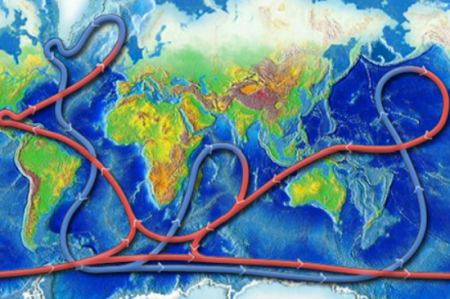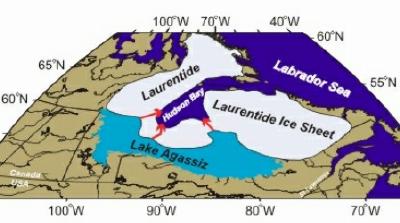May 25, 2015 – In a Nature Geoscience Letters article published last week and entitled Pacific origin of the abrupt increase in Indian Ocean heat content during the warming hiatus, researchers produce evidence that the Indian is playing a role in dampening down the rise in atmospheric temperatures by absorbing much of the accumulating heat from carbon dioxide build up.
Oceanographers at the University of Miami in Florida had long suspected that La Nina conditions in the mid-Pacific play an important role in creating ocean heat sinks. In looking for evidence of the heat, however, they didn’t find it where they thought it would be, smack dab in the Central Pacific. In fact when they took the temperature of the mid-Pacific to depths of 700 meters (approximately 2,300 feet) they found pronounced cooling.
So what were they observing?
It was only a few decades ago when scientists first discovered the ocean’s circulatory system. Called the Global Conveyer Belt (see illustration below), caused by a combination of Coriolis Force from Earth’s rotation, the positioning of the continental plates, and atmospheric wind, this continuous movement of water affects both the surface and deep ocean. In the Pacific the water moves from east to west driven by trade winds. There is nothing new about this circulation pattern. It has been going on pretty much continuously since the continental plates we see today drifted to their present positions.
So why a difference now?
Winds play a significant role in moving large volumes of water. They create much more than waves as friction between water molecules transfers motion downward to affect mid to deep ocean water movement. A wind blowing steadily at 30 kilometers per hour across an ocean surface has the potential to push a volume of water to a depth of more than 150 meters accelerating it as much as 0.7 kilometers (0.4 miles) per hour over that period of time.
And that phenomenon is the explanation for why the heat that formed in the Pacific is not there now and the Indian Ocean has emerged as the significant heat sink of the first decade of the 21st century accounting for 70% of global heat gain and keeping global temperatures from rising as quickly as some climate modelers previously predicted.
It appears that the Eastern Trade winds have strengthened during the decade in response to La Ninas pushing heat being absorbed by Pacific surface waters westward through the straits on either side of the Indonesian archipelago and into the Indian Ocean. In modeling the climate of the two oceans the scientists can show just how this is happening.
Inter-ocean heating is a relatively new field of study. And we have only recently begun to understand how El Nino and La Nina oscillations play a role in this, specifically the interaction between the Pacific and Indian Oceans. During a La Nina weather systems strengthen over the mid-Pacific and weaken over the eastern Indian Ocean. This strengthens wind currents blowing from the east. And where the wind goes so does the ocean.
What does this mean for the rest of the 21st century?
The study suggests that at some point the accumulated heat in the Indian Ocean will spill over into the South Atlantic which is already experiencing accelerated warming on its own. This continued build up within the global ocean heat sink is expected to carry on throughout the 21st century with significant implications for flora and fauna, fisheries, global precipitation patterns and even the Global Conveyer Belt itself.
When was the last time the Global Conveyer Belt was disrupted?
At the end of the last Ice Age in North America a large freshwater lake appeared in the central part of the continent. Known as Lake Agassiz (see picture below) it was formed by the accumulated melt waters of the Laurentide Ice Sheet which as it disappeared left a temporary ice dam blocking the outlet to the North Atlantic. Throughout its more than 4,000 years of existence Lake Agassiz changed dramatically sometimes draining through what would become the Mississippi River valley and sometimes draining northward through the future Mackenzie River valley. One notable event 12,800 years ago affected the Global Conveyer Belt when that St. Lawrence ice dam finally broke. The North Atlantic was suddenly flooded by cold freshwater which overrode the heavier ocean saltwater disrupting the Gulf Stream and creating a mini-Ice Age in Europe that appears in the geologic record. Known as the Younger Dryas it would have transformed Europe’s ecosystem within a single season, a mere three months.
What happened with Lake Agassiz illustrates how imbalances on our planet can have significant impacts on climate and life. The heating of the Indian Ocean is symptomatic of this type of imbalance and we need to understand the long term implications for the planet.





















